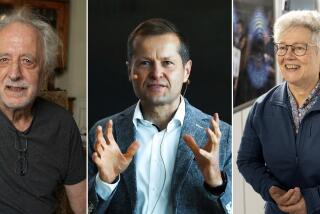How scientists detected gravitational waves for the first time
- Share via
Scientists have announced the first detection of gravitational waves, a finding that will give astronomers an entirely new window to the universe. But how are these waves observed and why have we never seen them before?
Gravitational waves are ripples in the space-time continuum first predicted by Albert Einstein 100 years ago.
They can be produced in many ways, but their effect on time and space is so infinitesimal that it requires the motion of massive and dense objects like black holes and neutron stars to create gravitational waves strong enough to be observed by instruments on Earth.
Scientists say the first gravitational waves to be detected were caused by two black holes, each about 30 times the mass of the sun, smashing into each other and merging.
But even then, the resulting waves were barely perceptible. For example, they caused the arm of a 2.5-mile instrument designed to measure them to lengthen by just 1/1000th the diameter of a proton.
No wonder Einstein never thought they would be measured.
It took several decades for researchers in the United States to design and build two observatories that were sensitive enough to “hear” gravitational waves. One is located in Louisiana, the other in Washington state. They are run by a consortium of scientists in the LIGO Scientific Collaboration. (LIGO stands for Laser Interferometer Gravitational-Wave Observatory.)
The observatories consist of two tubes, each 2.5 miles long, arranged in an L shape.
When the experiment is running, a laser beam is emitted from the corner of the L, where the two tubes meet. A beam splitter directs half the light from the beam down one tube, while the other half is sent down the second tube. At the end of each tube is a mirror that reflects the light back to the point where it was split.
See the most-read stories in Science this hour >>
If the tubes are the exact same length, the light should take the same amount of time to travel down each arm. However, if a gravitational wave should happen to pass through the instrument, it would stretch one arm of the L just a teeny bit, while compressing the other arm just a teeny bit.
In that case, it would take one beam of light a bit longer to make it down the tube and back, while the other beam of light would take just a bit shorter.
“The remarkable fact is that the gravitational wave is stretching the space between the mirrors,” said Jonah Kanner, a research scientists at the LIGO laboratory at Caltech. “It’s not that the mirrors move, it’s that the space between them gets stretched. But because the speed of light is constant, it takes the light a longer time to make the trip.”
The trouble is, it isn’t just gravitational waves that can cause a length change in one of the arms. The instruments are so sensitive that they will also detect a truck rumbling down the street, a storm brewing in the distance, or a dropped book in the control room.
That’s why having two observatories is essential, researchers said.
“You need two detectors because what you are looking for is coincidence,” said Surabhi Sachdev, a graduate student at Caltech who works on LIGO data. “If you see the same signal at the same time in both locations it is more likely real. You don’t expect the noise to randomly be the same.”
The instruments record a data point 16,000 times a second, and that too is necessary. The first signal to be detected lasted just 200 milliseconds.
Once a signal is identified, scientists can determine what caused it by checking it against computer simulations of different types of wave forms.
“Computer theorists produced a library of different kinds of signals you can expect if you change the mass and the spin of the objects involved,” said Avi Loeb, an astrophysicist at Harvard University who was not involved in the research. “It is like a fingerprint. It’s not as if you can fit the data with anything.”
And that, said Max Isi, a graduate student at Caltech working with LIGO, is what is so thrilling about the project.
“It is really mind-boggling that an equation written by someone 100 years ago predicts exactly what happened 1 billion years ago, and which we only just detected,” he said. “To describe an event so remote in time and space and so far away from our own experience is really amazing.”
Do you love science? I do! Follow me @DeborahNetburn and “like” Los Angeles Times Science & Health on Facebook.
MORE FROM SCIENCE
Zika virus found in fetal brain
Belief in all-knowing, punitive gods aided the growth of human societies, study says
With a deft snip, potential treatment emerges for deadly childhood Duchenne Muscular Dystrophy







